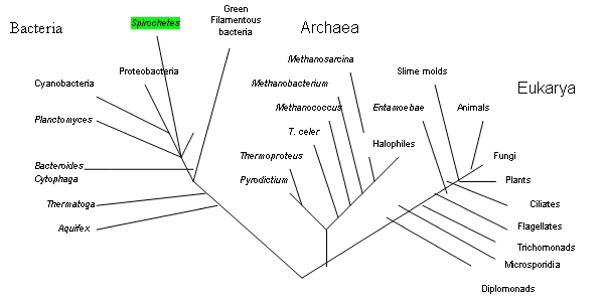|
Borrelia burgdorferi? - Now that's a mouthful that needs
explanation!!
Species Name:
Borrelia
burgdorferi
Common Name:
No common name.
Like all organisms, this bacterium has been named based on the
Linnaean system which organizes all living things into a
hierarchical system. The various parts of
this system include (from most general to most specific): Domain,
Kingdom, Phylum, Class, Order, Family, Genus, and Species. The
classification of Borrelia burgdorferi is as follows:
Domain: Bacteria
Kingdom: Prokaryotae
Phylum: Spirochaetes
Class: "Spirochaetes"
Order: Spirochaetales
Family: Spirochaetaceae
Genus: Borrelia
Species: Borrelia burgdorferi
-
Borrelia burgdorferi
is classified in the
domain Bacteria because it's an unicellular microorganism with a cell
wall made of peptidoglycan, and unique RNA polymerase (As opposed to
Achaea's cell wall made of polysaccharides and RNA polymerase
similar to Eukaryotes).
-
This species is listed in the kingdom Prokaryotae because it is a prokaryote organism meaning that it does
not contain a nucleus and contains significantly less membrane-bond
organelles.
-
The classification within the phylum Spirochaetes
and class "Spirochaetes" indicates that this species is
"Gram-negative, helically shaped, [contains] highly flexible cells
motile" by a flagella located outside the plasma membrane,
called a periplasmic flagella. (Brenner, D., Krieg, N., & Staley, J., 2005
).

-
Borrelia burgdorferi
fit into the order Spirochaetales because they are a parasitic and
pathogenic species.
-
The family grouping, Spirochaetaceae, indicates
that this species is anaerobic or facultatively anaerobic (meaning
can adapt to live in either aerobic or anaerobic environments).
-
The genus
Borrelia includes bacteria with all the above characteristics
and specifies that the bacterium acts as parasites or pathogens
in human and other animals (Singleton, P., & Sainsbury, D.,
2006).
-
Borrelia burgdorferi is a species that is known
to cause Lyme Disease.

These organisms respresent the species that are very similarly
related to Borrelia burgdorferi. All of these organisms
are found in the genus
Borrelia and are distinct from one another in the
symptoms that they cause.
For example,
Borrelia
hermsii and
Borrelia parkeri cause a
relapsing fever whereas
Borrelia
garinii is responsible for causing
neurological problems associated with Lyme disease. Additionally
these strains are found in different areas of the world (Ginsberg,
H., 1993).
|